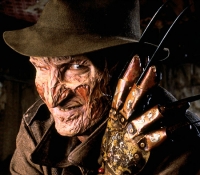Freddy vs. Jason
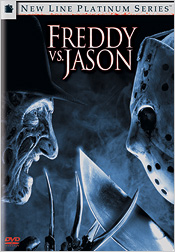 In 1992, New Line Cinema had acquired the rights to the Friday the 13th franchise after Paramount Pictures had allowed their sequel rights to lapse, giving steam to a project that was trapped in development hell for nearly two decades. Finally coming to fruition almost nine years after the Nightmare series had ended (and almost ten years after the Friday the 13th series had also ended), Freddy vs. Jason was the long-awaited match-up that fans had been keeping tabs on since the project went into development in 1987.
In 1992, New Line Cinema had acquired the rights to the Friday the 13th franchise after Paramount Pictures had allowed their sequel rights to lapse, giving steam to a project that was trapped in development hell for nearly two decades. Finally coming to fruition almost nine years after the Nightmare series had ended (and almost ten years after the Friday the 13th series had also ended), Freddy vs. Jason was the long-awaited match-up that fans had been keeping tabs on since the project went into development in 1987.
The original script for Friday the 13th Part 7: The New Blood was originally meant to be the penultimate clash between the two titans, but when New Line and Paramount couldn’t work out an agreement over the distribution and character rights, the script was re-written and turned into the familiar Friday sequel that we all know. A myriad of different writers and scripts passed through the studio’s hands until a screenplay worth putting into production could be found. In 2002, that finally came to pass and New Line green-lit the project with Bride of Chucky director Ronny Yu at the director’s helm.
The good news was that Robert Englund would be returning to portray Freddy, but the bad news was that Ken Kirzinger would be brought in to replace Kane Hodder as Jason. Kirzinger had doubled for Hodder in Friday the 13th Part 8: Jason Takes Manhattan, and according to the filmmakers, he was cast because he was much taller than Englund and more befitting of the director’s concept of the character. The decision to recast Jason caused an enormous amount of controversy in the fan community with most deriding the film before it even went into production. Kane Hodder himself was also upset by the decision, having been a cheerleader for the project for many years, but the controversy soon died down to just merely murmurings of disapproval. With their two leads in place, filming soon began.
According to the developers and writers on the project, it was important that the story never found itself trying to reinvent either character’s backstories. It could have been a bitter blow to either fan base if there was a deeper meaning to the duel at hand. An early concept placed Freddy as a camp counselor at Camp Crystal Lake in 1958 whereupon he both molested and drowned Jason. The concept was that Jason had returned from his watery grave searching for the counselor who did him in. Fascinating to think about, but ultimately, would likely have weakened the material rather than strengthen it. In the script that was eventually used, the adults of Springwood decide that the only way to defeat Freddy is to erase him from ever existing, and without the fear that he feeds on, Freddy can’t return to the dreams of teenagers. Fortunately, Freddy finds a way around that. His plan to bring Jason Voorhees back from the dead and go to Springwood to spread the fear for him backfires when Jason won’t stop killing Freddy’s children, leading to the eventual clash between them.
Released on August 15, 2003, Freddy vs. Jason was the biggest money maker of either franchise by a mile; drawing in nearly $83 million domestically and almost $115 million worldwide. Reactions from both fans and critics were mixed, but New Line had successfully achieved what they had set out to do with the film and reaped the rewards. What the film managed to deliver was a blood-soaked, ultra-violent and just flat out hard R-rated horror film. During the days that major studios wanted a PG-13 rating on most of their summer releases to get a bigger majority of moviegoers in to see them, it was a blessing that it didn’t happen with Freddy vs. Jason. The latter half of the film is a hack and slash the likes of which hadn’t been seen in a mainstream horror film for some time. With bloody debris, bone and appendages flying in every direction, it was exactly what many fans had been waiting patiently to see.
A sequel involving either Ash from The Evil Dead series or Pinhead from the Hellraiser series was discussed soon after, but never came to fruition. It could have been the start of another of the classic monster mash-ups from the 1930’s and 1940’s for a new generation of horror fans, but maybe sometimes it’s just best to wonder what if. Although, I have to say that I would much rather have seen that come to pass rather than what happened next.
A Nightmare on Elm Street (2010)
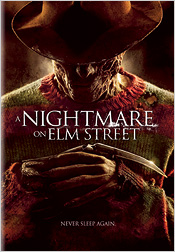 Now here’s where it gets really personal for me.
Now here’s where it gets really personal for me.
In the age of the almighty remake, A Nightmare on Elm Street wasn’t invulnerable to the Hollywood reprinting process that continues to tarnish the legacy of many a film. Ever since the announcement that a remake was in the works, fans moaned and groaned about it, and for good reason. How could anybody possibly re-capture not just the magic of the original, but cast an entirely new actor in the role that Robert Englund was born to play? Well, whether fans liked it or not, it happened. The production company Platinum Dunes and music video director Samuel Bayer set out to re-imagine one of horror’s greatest icons and failed on so many levels.
For starters, the cast of the Nightmare remake is miles apart from that of the original cast. Actors from the original film fit into their characters so well because they were more or less playing themselves, which helped make them more easily accessible to audiences. This time around, no one in any of their roles comes across that way. In fact, they’re so uninteresting that you generally don’t give two hoots about them. They’re, for the part, just the usual pretty faces that are slapped into mainstream horror movies instead of interesting characters that an audience might care about. Some might argue that waiting to see the characters get it in these films is what the whole ballgame is about, but I would disagree. If there’s one thing that the Nightmare series accomplished, even in the worst of sequels, it was to sympathize with its victims. If an audience is manipulated into relating to the characters on even the most basic of levels then they would also in turn feel sorry for them. That’s the way that the Nightmare series has always worked and why its appeal is much more broad than your usual slasher movie. If audiences want to see people they don’t care about getting hacked to pieces, they can watch the Friday the 13th series where that kind of thing is commonplace and acceptable.
The other great thing about the original series is that it maintains plenty of repeatability, but there’s absolutely nothing so spectacular about the remake that makes you want to see it more than once. Formulaic to the core, it’s just another entry into the “everyone’s dying, it’s a big mystery and we have to solve it” modern schlock fest that continues to be recycled over and over again in a plethora of others like it. There’s also nothing original and innovative about it. It’s just so average, bland and uninteresting that it makes you want to see the original films again just to get the bad taste out of your mouth (which is about the most positive thing I can say about it). It gathers together many of the moments and visual cues from the original films into a sort of greatest hits package without bringing anything new to the table. Of course, each sequel in the original series wasn’t particularly innovative, but they were crafted with much more thought and care than just Xeroxing ideas and concepts.
The biggest flaws in the remake of A Nightmare on Elm Street were the changes made from the original story. Not only could the filmmakers not create something fresh, but they also changed and flawed the series two biggest characters: Freddy himself and Nancy. In the new version of Freddy’s backstory, he tends to the gardening of a pre-school, living in the basement and befriending the children who attend there, which we later find out was more than just friendship. The film, for a while at least, plays with the idea that maybe the vigilante parents who went after him were mistaken and that Freddy might have been an innocent man who was back for revenge, only later to find out that they’re wrong. This flaws Freddy as a character and makes his motives questionable. If Freddy is only back for revenge without having previously murdered anyone, that makes him relatable, and you’re not supposed to relate to your antagonist. Sure Freddy is popular as a character and audiences love seeing him do what he does, but never on the level of relating to him. As a character in this film, he’s definitely a bad person and does some atrocious and vile things to the children, but he was never a killer. It may not seem like that big of a deal, and the writers were probably trying to give both the parents of the children and Freddy himself a more precise reason to exact revenge, but Freddy loses his character essence in the process. I’m not saying that pedophilia and molestation aren’t evil things because they are, but in a character sense, Freddy’s motives are flawed. In other words, Freddy was a more complete character in the original series with enough character motivation that extended beyond what he did in reality.
And even though Jackie Earl Haley is a fine actor and does the best that he possibly can, even inside a flawed character, no actress could have done anything with the character of Nancy. In this version, she is very loosely based on the original film’s Nancy Thompson, and I do mean loosely. This Nancy, played by the talented Rooney Mara, is a loner, keeps to herself and doesn’t really want much to do with anybody, especially the guy who’s the most interested in her throughout the course of the film. In other words, this is the “emo” version of Nancy. The problem with this is that not only does it also destroy the essence of the original character, it gives Freddy no opposition. You have a bunch of psychologically scarred teenagers running around without any inner strength to conquer their demons, and therefore, aren’t believable enough to go up against such a powerful force. To put it in perspective a bit, Nancy has always been Freddy’s greatest foe. She’s a strong young woman who doesn’t overly depend on others to help her in her time of need. Her bravery and strength is one of the reasons that the original Nightmare worked as a story. If she had been like Barbara from Night of the Living Dead, a weak, screaming and horribly useless character, she would have been dead in no time. Nancy also crossed likeability boundaries between sexes and not only did the guys want her, but the gals wanted to be her. So now, in the remake, we’re given this emotionally-crippled young woman who can’t really do anything on her own without the help of her pseudo-boyfriend (who, by the way, is merely there only to spew juxtaposition most of the time). The filmmakers have, more or less, diluted Nancy’s character and made her just another member of the cattle in the herd of the modern horror film industry. But, in spite of all of the flaws, the remake steam-rolled on ahead without any objections from anyone about its flawed content.
Released on April 30, 2010, A Nightmare on Elm Street definitely pulled in a very good revenue for the studio due to name recognition alone, but was met with mostly negative critical and die-hard fan response. As for myself, I left the theater on opening day feeling underwhelmed an unimpressed. I really tried my best to set my bias aside and judge the film of its own merit, but when it takes so many elements from the original films without trying to do anything new, it’s really difficult to do that. Ultimately, if you’re remaking a film, your final product is going to be judged against the original no matter what. There’s just no getting around that, and the remake of A Nightmare on Elm Street pales in comparison to the quality of the original film.
As of this writing, the franchise ends here. There are talks of another sequel in the works, which I hope doesn’t come to fruition, but if it does, I would hope that a little more care would be taken in the writing and execution processes to make it something interesting.
Never Sleep Again: The Elm Street Legacy
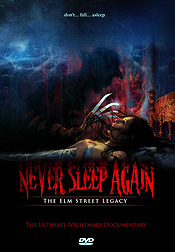 Despite its popularity and fan base enthusiasm, a documentary chronicling the entire Nightmare series had never been produced. In the wake of lavishly-produced DVD boxed sets like Blade Runner and Alien Anthology, which were crammed to the brim with extra content, A Nightmare on Elm Street was never given the level of treatment that it deserved. But in 2010, a small production company of filmmakers and fans put together a massive documentary on the entire history of the Nightmare series entitled Never Sleep Again: The Elm Street Legacy.
Despite its popularity and fan base enthusiasm, a documentary chronicling the entire Nightmare series had never been produced. In the wake of lavishly-produced DVD boxed sets like Blade Runner and Alien Anthology, which were crammed to the brim with extra content, A Nightmare on Elm Street was never given the level of treatment that it deserved. But in 2010, a small production company of filmmakers and fans put together a massive documentary on the entire history of the Nightmare series entitled Never Sleep Again: The Elm Street Legacy.
Clocking in at around four hours, this documentary devotes nearly half an hour to each film in the series plus the short-lived A Nightmare on Elm Street: The Series - Freddy’s Nightmares TV show. It’s an absolute treasure trove of never-before-seen material interspersed with interviews that include almost every major actor or crew member involved with each film. It’s actually the first time that a good 50% of these people have spoken on camera in years (or possibly ever) about the series. Some of the more successful actors weren’t available to take part in it, such as Johnny Depp and Patricia Arquette, but the sheer wealth of participants outshines these minor losses. It also features wrap-around stop motion segments and original music for the opening titles by Charles Bernstein. Included in the documentary is a collection of rare material including deleted & behind-the-scenes footage, storyboards, personal photos, and even props & memorabilia. The filmmakers also provide an audio commentary for those interested in the making of the documentary itself.
This 2 disc set also comes with a bonus disc absolutely stuffed with extra material that didn’t make it onto the first disc. Extended Interviews contains even MORE material that couldn’t be shoe-horned into the main feature (even devoting a couple of minutes to talk about the Nightmare remake); First Look: Heather Langenkamp’s I Am Nancy is a brief look at the documentary exploring the franchise as it relates to her; For the Love of the Glove takes a look at Freddy’s right-handed trademark, and the fans that have devoted their time, money and energy into creating their own gloves; Fred Heads: The Ultimate Freddy Fans focuses on the fandom of the series; Horror’s Hallowed Grounds: Return to Elm Street is a featurette from the infamous web series that revisits the locations seen in the original film; Freddy vs. The Angry Video Game Nerd takes a look at the YouTube superstar and the video game of A Nightmare on Elm Street; Expanding the Elm Street Universe: Freddy in Comic Books & Novels delves into the fan fiction and media created by various contributors; The Music of the Nightmare: Conversations with Composers & Songwriters sheds some light on the series’ musical scores and original songs with most of the people involved in creating them; Elm Street’s Poster Boy: The Art of Matthew Joseph Peak is a look at the man who did the poster artwork for most of the original films; A Nightmare on Elm Street in 10 Minutes is a humorous take on the original movie; and finally, following it all up is the Never Sleep Again: The Elm Street Legacy teaser trailer. There’s also a very funny Easter Egg featuring Charles Fleischer, who appeared in the first film. Obviously the main feature is the reason to get this, but this is a wonderful set of supplements to append it.
Released on October 5, 2010, Never Sleep Again: The Elm Street Legacy was an instant hit with fans. It also received rave reviews and won various awards the year of its release. As a sort of compendium to the series, it was also an entertaining story told through the eyes of the people who worked on it and guided its journey. It also spawned a slew of horror retrospectives and documentaries that continues to this day. If you’re a horror fan at all, it truly is the holy grail of documentaries. It’s so wonderfully paced and entertaining that the four hour running time is never an issue and just flies right by with little notice. It’s a labor of love that honors both the series itself and the studio that produced it. It’s also bittersweet as you realize that the series is over and will never be as prominent as it once was. Seeing Robert Shaye thank the fans with heart-felt gratitude for their support with the look of sadness in his face says it all, and it’s a wonderful way to close out not just the documentary, but the Nightmare legacy itself.
It was just a dream...
One has to wonder just where the Nightmare franchise could possibly go from here, if anywhere? I’m almost certain that we haven’t seen the last of Freddy Krueger, whether he’s being portrayed by Robert Englund or not. Regardless, I’ll continue to be an avid fan of the series but I’d also like to see it get its due on both DVD and Blu-ray, the deluxe way (its lackluster Blu-ray debut doesn’t count). For a series that built a movie studio up from nothing and launched the careers of many successful actors, directors, makeup artists, special effects technicians and producers, I believe it has a place in history and deserves only the best of treatment, and I hope that I’m still around to see that happen.
In any case, it’s been both a pleasure and a privilege to discuss the Nightmare series with all of you and I hope that you’ve enjoyed this little trip down memory lane as much as I have. I’d also like to thank my cohorts here at The Digital Bits for their constant support and friendship.
To them and to all of you, Happy Halloween!
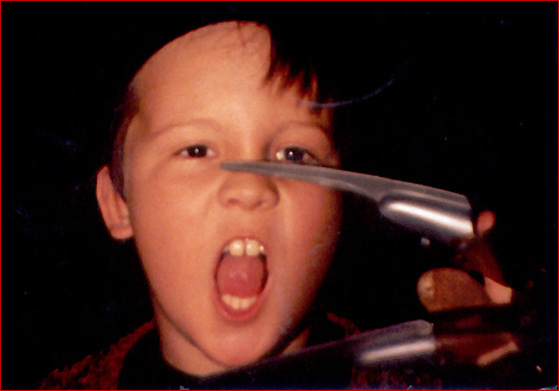
- Tim Salmons


